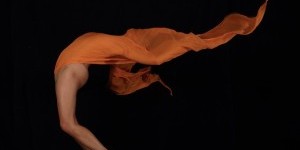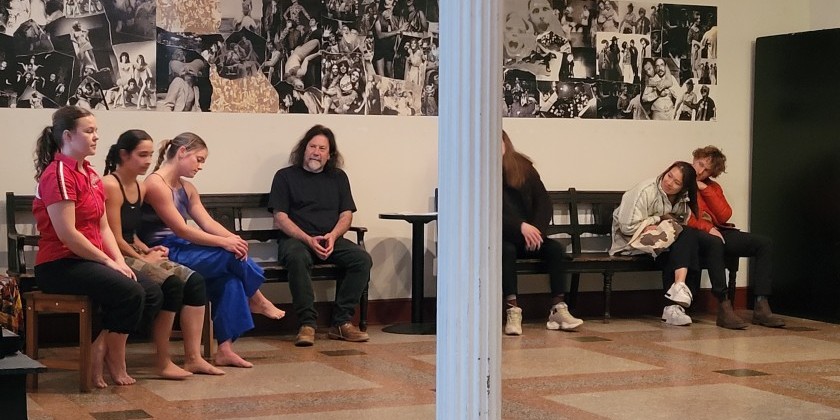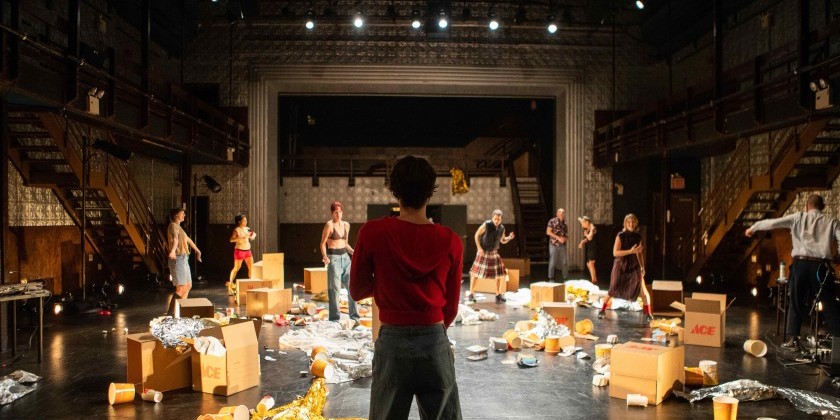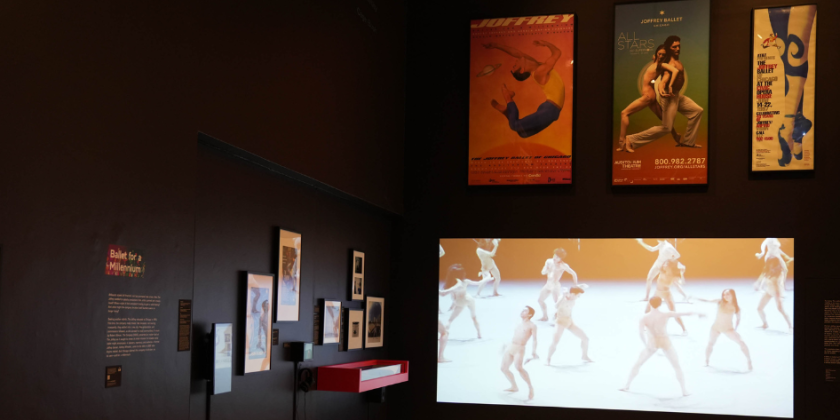JANE COMFORT: 40 YEARS IN THE RESISTANCE
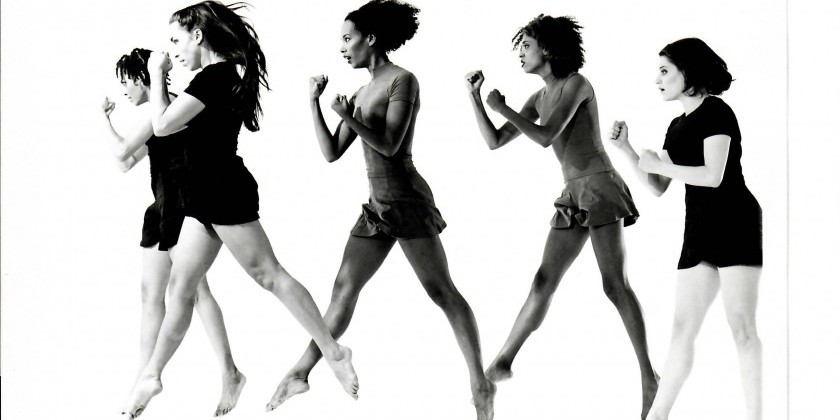
As the Choreographer Prepares for her 40th Anniversary Retrospective - Presented at La MaMa in Association with The Lumberyard
Jane Comfort 40th Anniversary Retrospective
Ellen Stewart Theatre | 66 E 4th Street; 2nd Floor
Thursday at 7:30PM; Friday to Saturday at 8PM; Sunday at 4PM
$25 Adult Tickets; $20 Students/Seniors (plus $1 Facility Fee)
Choreographed by Jane Comfort
Presented in association with Lumberyard for Tickets click here
(Dancers in Top Photo are: Stephanie McKay, Suzanne Nece, Edisa Weeks, Christina Redd Johnson, Rebecca Hermos)
“Dancers used to live here,” choreographer Jane Comfort says, gesturing beyond the sunlit windows of her Tribeca loft. “We all lived down here because it was cheap.”
That was in the 1970s. Downscale no longer, the neighborhood now boasts Issey Miyake’s flagship store, luxury apartments, and restaurants with sleek marble counters. The choreographer and her husband, John, are hold-outs in their building, a former warehouse entered via the loading dock. Her prosperous new neighbors are better acquainted with designer fashions than with the funk of tired bodies. Even Comfort doesn’t rehearse here much, having outgrown the studio with its space divided by white-washed columns supporting iron girders.

Today, however, the members of her dance troupe, Jane Comfort and Company, scamper through the narrow space between the columns and a side-wall lined with mirrors, just as they used to do. They are preparing for an upcoming season, April 5-8, at La MaMa, by rehearsing “Altiplano,” a mysterious dance inspired by the highlands of South America, The engagement co-presented by La MaMa and The Lumberyard, will be a milestone in the company’s history, celebrating its founding 40 years ago with a special, retrospective program.
“Yeah, all of a sudden four decades went by, and you’re like, ‘What?’” Comfort says, widening her eyes in surprise. Now 72 years old, she spent her childhood wearing dog tags and lining up for evacuation drills in Oak Ridge, Tennessee, a military and scientific community that the US government established as part of its project to develop the atomic bomb. She studied painting at the University of North Carolina, before moving to New York in 1971, after a stint in the Peace Corps. She and John moved into their loft in 1979, and raised two children: Gardner and Claire.

Nibbling on bits of cheese, Comfort watches the action in the studio sharp-eyed. Two dancers lock arms, standing face-to-face, but the symmetry breaks down repeatedly as a man is yanked to one side; a woman bursts through the middle; and another man is thrown over his own leg twisting and kicking. Comfort may be best known for her provocations, talking while she dances and tackling inflammatory issues in pieces like “Deportment;” “An American Rendition;” and “Beauty,” but anyone who dreams up such an intricate and lively sequence of movements doesn’t need to talk. This artist has a brilliant grasp of choreographic composition, as well as a social conscience, and a wicked sense of humor.
Comfort began her career as a Minimalist, admiring the pure lines and rhythmic subtleties in Merce Cunningham’s dances, and listening to the music of avant-garde composers Philip Glass, Glenn Branca, and Laurie Anderson. Comfort’s first creation was the solo “Steady Shift,” a tactile exploration of her own body. Yet while viewers described this 1978 piece as mathematical, they didn’t know what Comfort was thinking. Is there any way, in our sexist society, that a woman’s body can escape being political?

Now Comfort admits that at the time she made “Steady Shift” she was worried about the consequences of becoming pregnant. “I had such a fear that if I became a mother I would close the door on being an artist,” she says. As she touched herself, she was asking, “Am I here? Will I still be here?” “Steady Shift,” in retrospect, was the prelude to a string of outspoken and politically awake dances.
A few years later, Ronald Reagan was elected president; and, like many progressives at that time, Comfort was appalled. The result was “Four Screaming Women,” the piece in which she started talking, making her own music with short, rhythmic phrases that seemed to channel Gertrude Stein. “Did you vote?” Comfort asked, interrogating her audience. “Did you win? Did you win, when you voted? Did you win?”
Significantly, while Comfort had apprenticed in the rarefied atmosphere of the Cunningham studio, she began dancing professionally with another, very different artist---James Cunningham. In contrast to Merce, the latter Cunningham was flamboyantly theatrical. “Everything was up on that stage,” Comfort recalls. “Also, the ground was shifting culturally.”

Contrasting artists her age with those who, only ten years earlier, had renounced theatricality and sought to erase the dramatic legacy of modern dance, she says, “We always felt like we had nothing to rebel against.” Post-modernism’s second wave had begun.
In those days, Comfort was also studying Afro-Brazilian dance with the late Lorimel Machado. Her interest in verbal rhythms, and polyrhythms, led to the creation in 1984 of “Artificial Horizon;” and a section of this work called “Street Talk” will be excerpted at La MaMa.
Burying her head in rhythmic abstractions was not an option, however, for it was around that same time that Comfort’s friends started falling ill and dying of AIDS. “John [Bernd] was one of the first,” she recalls. “John and I would go to Open Movement [on Monday’s at PS 122];” and people would be dancing, and people would be talking because of the AIDS thing. Exercises on six, or a pirouette weren’t going to do it. So, there was a lot of language. And because I had been writing almost my whole life, it was something I could do.”

Comfort kept a journal; and mixing words with steps, she explains, allowed her to put more of her life into her dances. Describing “Deportment,” the 1992 piece in which she and Mark Dendy portrayed a pair of Southern ladies, genteel on-the-outside but rotten on-the-inside, Comfort says, “The whole piece is about language. It’s about bigoted, racist language.
“Southerners are very good at telling stories. And they’re funny. So you’re saying the most hateful things, but it’s hilarious because of the way it’s phrased. I decided we’d do misogyny, homophobia and racism. And we would just go inch by inch, until we’d set off a bomb with the ‘N’ word. Well, it’s actually the ‘N-dick’ word.” Surprisingly, perhaps, “Deportment” and its sister piece, “Deportment North,” which concluded with a simulated rape, not only were a smash hit at PS 122, but also toured successfully, overcoming presenters’ attempts at censorship and stimulating a response that included both righteous glee, and outrage.
“It was funny, and then it wasn’t funny,” Comfort says. “There’s a quote I always think of: ‘The Devil slips into the room on a tinkle of laughter.’”
Given today’s climate, however---snowflakes every day---and the need for “trigger warnings,” Comfort feels “Deportment” is too dangerous to revive. So the audience at La MaMa will only see and hear carefully edited video selections from that work. Fans of Dendy’s infamous drag persona will, however, get to see him reprise his role as Amanda Wingfield in Comfort’s 1993 piece “Faith Healing,” which draws on Tennessee Williams’ classic play “The Glass Menagerie.” Dendy is one of many collaborators and former company members enthusiastically returning to take part in this retrospective.
Forty years of achievement are, understandably, too many to fit into a single bill of fare, so the La MaMa program is also notable for its omissions. Absent, for instance, will be “Cliff Notes: Macbeth,” the 1988 story of a hostile takeover inspired by the prior year’s stock-market crisis; “Persephone,” from 2004, Comfort’s foray into European-style dance theater; and, most regrettably, perhaps, “An American Rendition,” a courageous indictment of the US government’s illegal abduction and torture program, made in 2008. These works, the choreographer felt, were too difficult to excerpt and present out of context.

On the other hand, viewers will see a portion of “Asphalt,” an operatic collaboration between Comfort and novelist Carl Hancock Rux, with music by Toshi Reagon and DJ Spooky, which received its premiere in 2002. “Beauty” will be there, too, from 2012---Comfort’s take on women’s bodies and the exhausting chore that women face when they try to compete with Barbie dolls. So will “Underground River,” from 1998, a moving glimpse at the fantasies of a girl who lies seemingly unconscious in a hospital bed. More recent---and more “fancy-dancey”---creations like “Altiplano” and “You Are Here” will bring up the rear. “In the last few years I have wanted to make an abstract piece,” Comfort says, adding, “I might, one day, get there.”

Explaining that she solicited requests in assembling the retrospective program, Comfort notes that the piece receiving the most requests was “S/He,” her 1995 response to the Anita Hill case, in which Hill, a congressional staffer, accused her former boss, then Supreme Court nominee Clarence Thomas, of sexual harassment, only to be pilloried herself. In Comfort’s ironic retelling, both the gender and the race of the protagonists are inverted. Although she made this piece more than 20 years ago, “S/He” dovetails neatly with today’s “Me, Too” movement; and, sadly, Comfort reflects, “Almost everything I did that was topical is still relevant.”
A highlight of next week’s program is expected to be “Amazing Grace,” reworked from 2016. Here audiences will be treated to a recording of Donald Trump accepting the Republican party’s nomination for president. As a growing chorus of people join in signing the title hymn on stage, however, they gradually drown-out his speech.
Asked what the future holds, Comfort replies that she wants to keep challenging herself, and, after a break, plans to tackle “something I don’t know how to do.”





